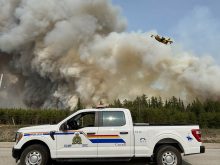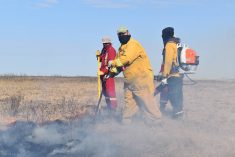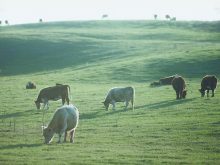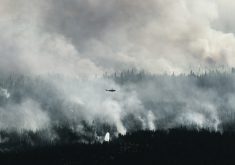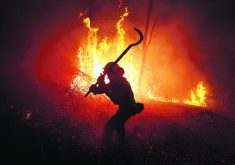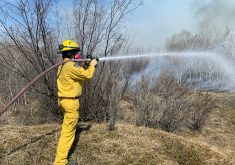The Senate’s agriculture and forestry committee has been studying the effects of wildfires on the two sectors
REGINA — Cattle producers described the stress of evacuating cattle during a forest fire in recent testimony at the Senate agriculture committee.
The committee wrapped up its study last week after hearing from a variety of witnesses in forestry and agriculture.
Among those was Stacey Meunier from Meunier Livestock at Barrhead, Alta. She talked about coping with fires in 2023.
Read Also

Taking a look inside Canada’s seed regulatory overhaul
ive years, eight task teams, 130 volunteers and 135 recommendations later, Canada’s seed industry is still waiting for meaningful regulatory change.
In May they had to move 2,300 head multiple times to ensure safety, but a shift in the wind would have resulted in a far different story, she said. Some smaller farms could evacuate, but there was no place to take that many animals. As well, cows were calving and couldn’t be moved.
“In an effort to protect grazing land and livestock, we fought the fire on our property with our own labour, tools, water trucks and tractors, and eventually we hired contractors to assist us,” Meunier said.
The local fire department fought the fire but used equipment and made fire breaks randomly throughout the ranch.
“The cleanup and repair of these fire breaks have been extensive and, since the land is so fragile, it will take many years for it to recover. Some of it will never be the same,” she said.
The next month, their feedlot near Niton Junction was in the Edson fire evacuation zone. Fire marshals wouldn’t allow them to access the feedlot, which contained 12,000 animals, and staff had to find alternate routes in so they could care for the animals.
Meunier said local fire departments should be trained in wildfire management. She also said livestock can’t just be left, and people shouldn’t be forced to break the law to care for them.
“Our local peace officer gathered names as we came and took the time to understand why we wanted in,” she said.
“Then, he allowed us in, so we were able to care for our livestock and take care of things while we were there. Not everyone will take that time and attention.”
Andrea Van Iterson from Westwold View Farms in the north Okanagan region of British Columbia agreed a formal accounting of who should be allowed in to help livestock should be part of a firefighting plan.
Her operation has twice been affected in the last few years.
In 2021, a fire at Osoyoos forced them to evacuate cattle on the range.
They moved the cattle to their home feedlot but then a local fire put them directly at risk. They decided to stay, along with their 1,100 head.
“We would have needed over 20 livestock trailers to evacuate these animals, and that simply would not have been possible for multiple reasons,” Van Iterson said.
There was no place to go and they wouldn’t have been able to find the trucks.
Then in 2023, the family had to evacuate 500 head due to the Rossmoore Lake fire. They relied on neighbours and others to help and were able to save all but seven animals.
“During both fires, our families were faced not only with the challenges of the impacts of the fire, but from the regulatory burden, miscommunication at many levels of government and being left to recover from these disasters,” she said.
Van Iterson recommended better regulations and communication at all levels of government, taking local input into account and developing a process to acknowledge some producers must shelter in place, provide some government assistance to do so, re-evaluate the assistance available and rely on local knowledge.
Van Iterson said there are no timely business risk management programs to help in these situations.
She added that targeted grazing projects are helping remove the fuel beneath forest stands to help slow down fires.
Kevin Boon, general manager of the B.C. Cattlemen’s Association, attributed many fire causes to “gross mismanagement of our landscape.”
He said planting too many trees in too small an area is creating fuel load.
“We have learned through the fires we have experienced that space between the trees with forage and shrubs being allowed to grow reduces fuels, and when we allow these to be grazed by livestock and wildlife, we reduce the fine fuels, and the fire risks are reduced as well,” Boon told the committee.
He said timber harvesting practices should be examined and healthier landscapes developed.
“We must also be careful that we do not make thoughtless political decisions without fully understanding the implications. Making commitments such as planting vast numbers of trees without a plan is very careless and detrimental.”
Boon said there have been several targeted grazing pilot projects using mainly cattle but also sheep or goats. They graze at specific times to remove fine fuels.
This can require selective logging ahead of grazing. He said an area can be reduced from 1,200 to 1,400 stems per hectare to 400 or 500.
Rick Doman, chair of the Boreal Carbon Corp., said dead and diseased forests are increasing the available fuel for forest fires. Mountain pine beetle and spruce bark beetle have decimated large areas.
“Climate change may be a contributing factor to these issues, with the root cause tracing back three decades to the emergence of diseased forests,” Doman said.
He said Canada should harvest its diseased forests because of the threat they present, even though there may be a cost to that. Some of the wood will be salvageable.




